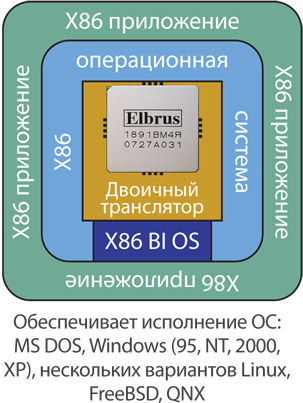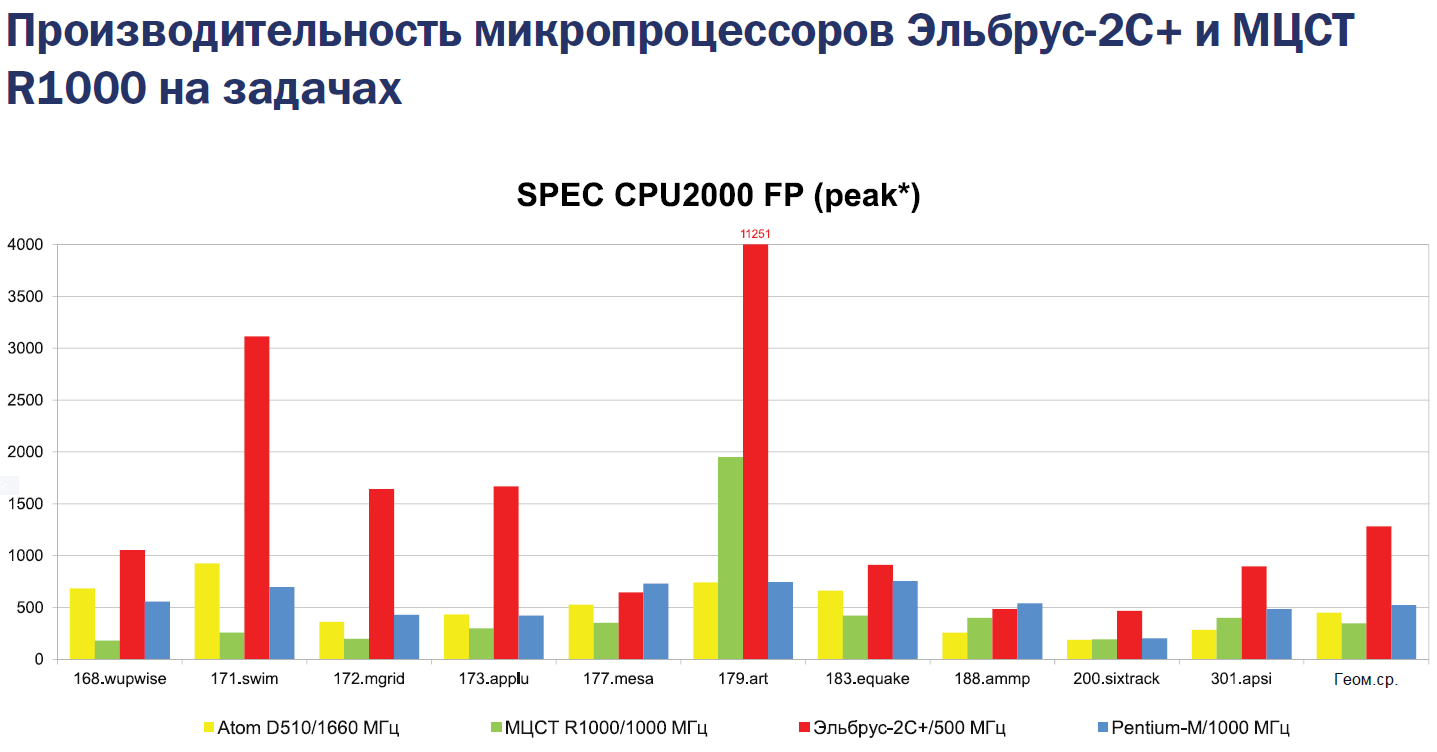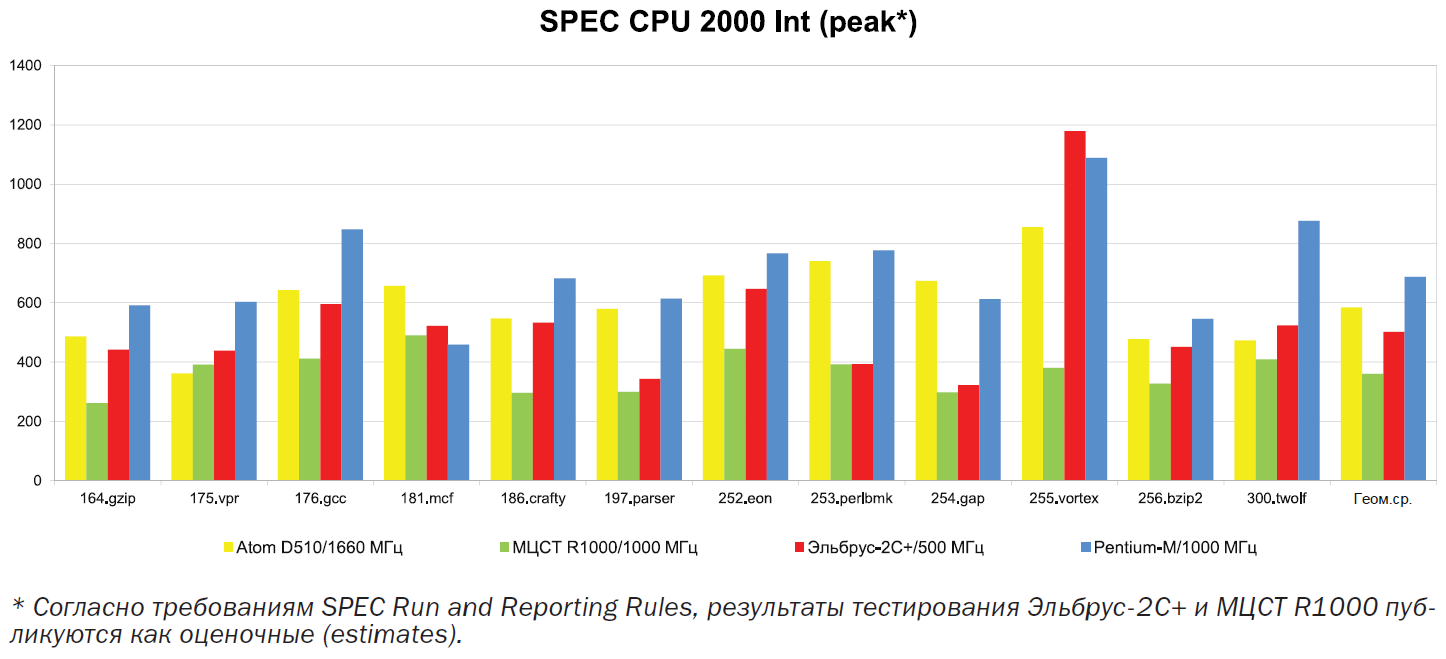Russian Company MCST Builds 'Elbrus-4C' CPU That Emulates x86 Programs
The Russian company MCST (Moscow Center for SPARC Technologies) released its quad-core Elbrus-4C CPU that will target high-performance PCs and servers.
Despite the company's own name, the chip is actually built on the proprietary "Elbrus" instruction set architecture and not on SPARC. The CPU cores are clocked only at 800 MHz each, and the chip is manufactured on a rather old 65 nm process. The chip has a TDP of 45 W, which isn't too bad considering its target market.
However, the performance may be lacking. Going by the MCST's own benchmarks (shown above and below), the CPU is only compared with older Atom chips that used to target netbooks or (also old) "Pentium-M" notebook processors. Even if the Elbrus-4C wins by a large margin in the floating point score, it does so against obsolete processors. When it is compared against the others for integer performance, the difference is much smaller.
The Elbrus architecture is a highly parallel VLIW architecture that executes instructions in the order established and optimized by the compiler. This is unlike other architectures, where the processors decide which instructions go first, which ones have to wait, and so on. This should help the Russian company build simpler (and cheaper) CPUs than the competition, at least in theory.
The architecture also allows for an easier emulation of x86 programs. The Russian government and Russian companies may want to reduce their dependence on Intel and AMD x86 CPUs, but in practice they will still have to depend on x86 programs, at least for a while longer, as few would probably want to target MCST's proprietary CPUs right now.
MCST is also selling a full computer (called Elbrus ARM-401) that comes with an Elbrus-4C-compatible Linux distro, although it also said that it's compatible with (the now obsolete and unpatched) Windows XP OS, as well as other x86 operating systems.
Pricing is unknown for the Elbrus-4C CPU, but considering it's barely faster than an old Atom CPU and is built on a 65 nm process, it's probably not going to cost too much.
Get Tom's Hardware's best news and in-depth reviews, straight to your inbox.
Follow us @tomshardware, on Facebook and on Google+.
Lucian Armasu is a Contributing Writer for Tom's Hardware US. He covers software news and the issues surrounding privacy and security.
-
Reminds me of the Loongson, it too emulated some x86 instructions. And was built on the 65 nm process. Maybe it came as part of a technological exchange between China and Russia.Reply
Couldn't Russia just buy an ARM licence, the fab the chips themselves, to ensure no backdoors or other nasty stuff? If that's the goal. And then emulate x86 via a virtual machine? Sounds a lot simpler than reinventing the wheel only to end up with a low performance chip. And TDP doesn't mean much. It's actually pretty high for a 800 Mhz chip @ 65 nm. -
childofthekorn Just the start of the technological independence we're going to be seeing. Sanctions away and the customers will be led astray. Still curious if the sanctions and ban of US tech companies providing russia with goods and services hindered resellers, if they keep stocks on hand of course.Reply -
Larry Litmanen ReplyJust the start of the technological independence we're going to be seeing. Sanctions away and the customers will be led astray. Still curious if the sanctions and ban of US tech companies providing russia with goods and services hindered resellers, if they keep stocks on hand of course.
Those sanctions are as effective as Iraq sanctions. All it means is Russian economy will be shifting to tech that uses Chinese or Korean tech.
-
greghome on a marginally similar note, I wonder what is stopping the chinese or in this case the russians from buying out AMD and using their tech expertise to build their own homegrown CPUs, except maybe congressReply -
amk-aka-Phantom ReplyCouldn't Russia just buy an ARM licence, the fab the chips themselves, to ensure no backdoors or other nasty stuff? If that's the goal.
on a marginally similar note, I wonder what is stopping the chinese or in this case the russians from buying out AMD and using their tech expertise to build their own homegrown CPUs, except maybe congress
Russian here. The goal, as usual, is to misuse/launder state funds, not actually achieve something meaningful. Everything else is just a cover-up. -
Svetoslav Enkov APM-401 computer with a 24GB ECC DDR3 is set to cost approx 4000 USD - too high price. And the processor Elbrus-4S is manufactured by TSMC, not in Russian fabs.Reply -
LostAlone Sounds like it's more of a research/development thing than an actual commercial chip. Obviously I can't read russian or anything, just that from the specs it feels like something to prove that the instruction set runs well and can handle x86 programs out of the box and then they can look at improving the fab process, speed and core count once that's done. That would actually make sense.Reply
If it's not then I have no idea what's the point of this at all. As others have said, there's no reason why they couldn't use an off the shelf ARM design with their own modifications which would be both cheap and radically easier to develop for. ARM might not be hyper popular in the desktop space but there's certainly lots of talent working on ARM chips and a solid amount of software too. A far better option than going propitiatory would be for Russia to throw their chips behind ARM as a desktop/server chip set - that would actually stand a chance of success.
I guess we wait and see, but just from the article this seems like an interesting but ultimately useless piece of hardware; a solution in search of a problem. You can certainly do a lot more with 800mhz these days than people think (especially on linux - plenty of office machines would happily run on that), but if you can manage on 800mhz then you can manage on an 800mhz ARM chip without even touching x86 software. -
Svetoslav Enkov More strange (I read russian native, was married to russian girl before too) is the fact that they do this for "eliminating Western CPU worms/trojans and so on" and then runs Western OS and System Softwares (and in emulation)... Better use cheap western CPUs and to make Eastern software and OS I think. Much less impact on the security...Reply


